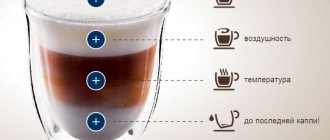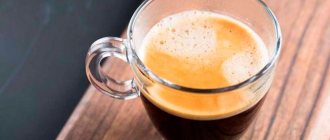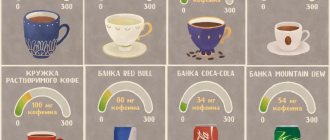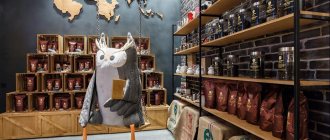Coffee is a tasty and aromatic drink that is very popular all over the world. Traditionally, roasted coffee beans are ground independently in a coffee grinder and prepared in a Turk. This process of preparing a hot drink allows you to preserve maximum taste and aroma, but it also takes a lot of time. A much easier and faster way to brew delicious coffee is to use a coffee machine.
Add coffee beans
Pour coffee into a cone
Consumption of coffee beans by different types of coffee machines
Before purchasing a coffee machine, you should think about the costs that it will require. In addition to the cost of the machine itself, you will have to spend money on purchasing suitable coffee and cleaning products necessary to get rid of scale and just dirt. Purchasing quality coffee beans will become a regular item in the family budget. This is why many people want to know how much coffee a coffee machine uses in grams. Accurate knowledge about this will help you save money.
The cheapest type of coffee machine is the drip type. The essence of their work is to heat water to a certain temperature, and then it enters the filter with ground coffee. The water is saturated with the taste and aroma of coffee beans, and then flows drop by drop into the coffee pot. How much coffee do you need per serving in a drip coffee machine? You need to pour 8-12 grams of ground coffee into the filter.
Philips 2000 Series coffee machine
A carob-type coffee maker heats water to create steam. Under pressure, steam passes through a layer of ground coffee beans, absorbing the aroma. One of the advantages of carob devices over drip coffee makers is the lower consumption of raw materials. So for one serving of coffee you need 5-8 grams of ground beans. Thus, one pack of coffee weighing 250 g is enough for approximately 40 servings of hot drink. To prepare a classic espresso, 7 grams of ground beans are enough, which corresponds to 1 heaped teaspoon. The volume of the finished drink will be 30 ml.
An automatic coffee machine requires the same amount of raw materials as a carob-type device.
Owners of capsule machines do not have a question about how much coffee they need per cup in a coffee machine. Typically, one serving of a hot drink requires 1 capsule. The strength of the drink can be adjusted using cups of different sizes. Each capsule contains the exact amount of coffee, sugar and milk. If you use 1 capsule to prepare several servings, the drink will not have such a rich and rich taste.
Coffee machine in the interior
To save on raw materials for a capsule coffee machine, you can buy reusable capsules, but they are not suitable for all devices. Manufacturers produce reusable capsules for coffee machines from the Nespresso, Lavazza, Tassimo, and Dolce Gusto lines. Initially, such a capsule contains coffee beans for 1 serving of the drink. After the first use, the capsule is opened, cleaned, and then you can pour coffee into it and put it back into the coffee machine.
Attention! One refillable capsule can be used to create approximately 50 servings of coffee. Then the membrane begins to deteriorate.
Characteristics
Traditional portion
The classic espresso coffee recipe includes water and ground coffee powder.
A standard serving of espresso is 25-35 ml. In northern Europe it is increased to 40-45 ml, and in the USA - to 50 ml. In Russia you will be offered a serving of up to 50-60 ml. But according to the rules, this is already a double espresso - doppio.
Temperature of the finished drink
To prepare espresso, the water temperature should be between +88 and +93 degrees. When the barista makes coffee, its temperature is +88 degrees. In a cup it drops to +67 degrees.
Coffee is served in special cups with thick walls - demitasse - so that it stays hot longer. It is drunk quickly before it loses its aroma.
Sugar, cream and snacks
No milk or sugar is added to espresso. They change the taste and prevent the aroma from developing. Therefore they are served separately.
You need to drink coffee in its pure form. As a snack at the coffee shop you will be offered:
- bitter chocolate;
- candied candied fruits or nuts;
- hard cheese.
It is wrong to drink a drink with fish or meat. It also does not go well with light alcohol, beer or wine.
Interesting! Mochaccino coffee: what is it?
Some coffee shops may serve a glass of cold still water and coffee. You will find out why it is needed in the article “How to properly drink espresso with water.”
How many calories and caffeine are in one serving?
The calorie content of real espresso is 9 kcal per 100 milliliters, per serving - 2.25 kcal. If you add 1 spoon of sugar to it, the calorie content will increase to 22.
The type of coffee determines how much caffeine is in a cup of the finished drink. One serving contains 40-90 mg of caffeine. The more robusta beans, the more caffeine - 60-90 mg per cup. If coffee is brewed from Arabica beans, the amount of caffeine will drop to 40-50 mg.
Price for one cup
The cost of one serving in a restaurant is from 100 rubles and above. The cost in a cafe or to take away is 50-70 rubles.
The cheapest option is prepared at home. The cost of a serving will be 10-12 rubles.
Tips from coffee connoisseurs
It is worth noting that the volume of beans for preparing one coffee drink is a relative indicator that depends on the taste preferences of each person. There, many connoisseurs of strong coffee recommend pouring 1 tablespoon (11-12 grams) of raw material into the coffee machine to prepare 1 serving of the drink. How many cups will a coffee machine produce from 1 kg of coffee? About 80 cups. But such a dose cannot be called economical.
Coffee machine in the kitchen
You can reduce the cost of raw materials for a coffee machine if you drink not very strong coffee. For example, if you add 7 g of raw material to each serving of an invigorating drink, then you can get 142 servings from 1 kg of grains. When adding 5 g, the savings will be even higher: from 1 kg of raw materials you can prepare 200 servings.
All modern coffee machines come with instructions that indicate the dosage of coffee beans for 1 serving of an invigorating drink. Many manufacturers, for example, DeLonghi, Bosch and Philips, include measuring spoons with their coffee makers, which make the process of preparing coffee drinks easier.
Thus, the mass of beans poured into the coffee machine determines the strength of the hot drink. This is an individual indicator that depends on the taste preferences of each person. That is why, when calculating the mass of raw materials to be poured, you should first adhere to the numbers indicated in the instructions that come with the coffee machine. In the future, to save money, you can gradually reduce the dose of coffee beans.
What is espresso coffee
Espresso is not ordinary coffee, but a whole art presented in a small cup. This invigorating drink is just over 100 years old, but it has long conquered the hearts of coffee lovers around the world. Coffee gourmets know that the rich taste of espresso, its indescribable aroma, and velvety notes of aftertaste cannot be confused with any other drink.
The principle of preparing this type of coffee has been improved over the years. But its most important components have remained unchanged: freshly ground coffee beans and hot water - this ideal tandem is enough to obtain a high-quality product.
Carob coffee maker = espresso at home at a minimal price
Drinks based on coffee beans have existed since ancient times. The coffee we are used to - made from ground roasted beans - is a little younger, but its history goes back several centuries. For centuries, coffee has been brewed in the traditional way - in a vessel of water brought to a boil.
The new type of coffee was not only prepared in record time, it also had a rich, strong taste without excessive bitterness. 25-30 seconds of water passing through ground coffee is enough to extract substances that determine the taste and tonic properties of the drink, but the tannins that give it bitterness remain in the grounds.
Many people liked the taste of the drink, and very quickly espresso spread to coffee shops, restaurants and cafes around the world. Its greater popularity was hindered only by the fact that making espresso required bulky and expensive machines - not everyone could afford to buy one at home.
It was only in the 80s of the last century that automatic coffee machines capable of preparing espresso began to be produced - they were cheaper, but still only affordable for wealthy people.
Historical reference
The name of coffee comes from the Italian espresso, which means “expressed”, “squeezed out”, as it is prepared under pressure and has a rich taste. Some people pronounce "express", but this is incorrect.
The term originated in the early 20th century when Italians sold freshly cut espresso spaghetti. Other meanings of the word: “made under pressure”, “compressed”.
The Italians have come up with a way to make natural, strong coffee in less than a minute. In 1901, engineer Luigi Bezzera from Milan invented a device in which hot water was forced through ground coffee powder under pressure.
Espresso in a coffee machine is prepared in 30 seconds.
Device of a carob coffee maker
The figure shows the device of the simplest steam coffee maker. In it, pressure is created by steam generated when water boils in the tank. The water passes through a valve that opens at a given pressure and enters the filter with a compressed coffee tablet.
To prepare the milk foam used in some coffee drinks, milk is frothed with a stream of steam, and carob coffee makers are usually equipped with a manual cappuccino maker - a device for frothing milk. To supply steam to the cappuccino maker in simple coffee makers, turn the water/steam switch.
In expensive carob coffee makers, pressure is created using a pump, and steam is supplied to the cappuccino maker from a separate boiler, so you can whip up foam and prepare espresso on them at the same time.
What does the coffee machine power?
So, let's list the points without which the coffee machine will not give you a delicious drink.
- Electricity
- Coffee beans (roasted)
- Water
- Milk (for cappuccino lovers)
- Desserts (yes, but you thought you’d just drink coffee)
- Maintenance (the coffee machine requires attention like a car)
- Unexpected coffee machine repair.
Now let's figure out point by point where, what and how much. Costs are average and relevant for Moscow.
Characteristics of carob coffee makers
The pressure created inside the filter holder is one of the main parameters of carob coffee makers. To properly prepare espresso, the pressure in the coffee filter should be 8-9 bar.
Unfortunately, it is not easy to ensure a stable pressure of this magnitude in steam coffee makers, so the pressure in the filter is lower - 2-6 bar. You cannot get a classic thick espresso with such a coffee maker - the result will be closer to a lungo or even an Americano.
The passport of a pump coffee maker usually indicates the maximum pressure of the pump; to create 9 bar on the filter it must be higher - about 15 bar.
Coffee used
If the coffee is not compacted, the water will quickly flow through the filter without having time to absorb the soluble substances - the coffee will be under-extracted: liquid, with a weakly expressed taste and sourish.
In order not to bother with tamping coffee, many carob coffee makers provide the ability to use pods - ready-made compressed tablets of ground coffee in paper filter bags.
Some coffee lovers claim that without proper experience it will not be possible to tamp coffee correctly and it is better to use pods, others - that there is nothing complicated in tamping, and the pods give the drink a papery taste. The truth, as always, is somewhere in the middle: pods really simplify the preparation of coffee, but to learn how to compact a tablet to your taste, for most coffee lovers a few attempts will be enough. Well, besides, pods are noticeably more expensive than just ground coffee.
There is a cappuccino maker in almost all carob coffee makers - most often a manual one, which is a tube with a special nozzle through which hot steam is supplied.
To get milk foam using a manual cappuccino maker, the nozzle must be lowered into a cup of milk, and, catching the desired position of the cup with small up and down movements, achieve maximum foam formation.
The automatic cappuccino maker prepares the foam on its own - you just need to pour milk into a separate tank and press a button.
The automatic cappuccino maker has one drawback (besides the high price) - if it is not washed after use, the next time it is prepared, the taste of the foam will be spoiled by sour milk residues.
Coffee makers with a manual cappuccino maker are much cheaper, but it should be noted that preparing foam with its help requires some skill and experience.
The capacity of the coffee maker determines how much coffee the coffee maker can make in one cycle. It should be noted that the need for a large volume arises infrequently.
Firstly, espresso is drunk in small portions - a standard portion has a volume of 25-35 ml.
Secondly, in simple coffee makers the boiler is combined with a water tank and coffee preparation will begin only when the entire volume has warmed up to boiling temperature - on large coffee makers this can take quite a long time.
Thirdly, larger coffee makers are more expensive.
Heater type
A boiler is a vessel with a heating element - in simple steam coffee makers the boiler is the water tank itself, in pump coffee makers the boiler is located separately, and water is supplied to it using a pump.
The thermoblock is a heating element with a heat exchanger located on it. A thermoblock is used in some pump coffee makers; the water pumped by the pump is heated by passing through a heat exchanger, so immediately after switching on, a coffee maker with a thermoblock will begin dispensing the finished drink faster than a coffee maker with a boiler.
The disadvantage of a thermoblock is that it becomes clogged with scale faster and is more difficult to clean. Therefore, coffee makers with a thermoblock should be descaled more often.
Automatic decalcification makes this process easier - to clean a coffee maker with this option, you just need to pour a certain amount of the recommended cleaning agent into the reservoir and start the program.
And in coffee makers without automatic descaling, you will have to do the descaling yourself. The decalcification process should be described in the manual and usually consists of several runs of the coffee maker with and without cleaning agent in the reservoir.
Recommended cleaning products are also provided in the coffee maker's instruction manual. You can use regular citric acid instead - but with caution: damage to the coffee maker when using an unapproved cleaning product will void the warranty.
The anti-drip system is an electric valve that instantly releases pressure when coffee is finished brewing. This avoids unnecessary drops and dries the tablet, which makes it much easier to remove.
Adjusting the portion of hot water allows the coffee maker to independently pour the programmed volume of the drink. If this option is absent, the coffee maker, after starting to prepare coffee, will work until the tank is completely empty - or you will have to stop pouring manually.
If you pour hot coffee into a cold cup, it will quickly cool down. To prevent this, many coffee makers have a cup warmer plate.
It is usually located on top and is heated by hot water passing under the stove while coffee is being prepared.
Simultaneous preparation of several cups of coffee allows you to pour the prepared drink into two cups at once.
The holder of a coffee maker with this feature usually has two holes for coffee outlet - one for each cup. If you need to pour one cup, it is placed in the middle of the tray so that both streams fall into it.
If you were going to make two cups, this option will allow you to pour the coffee into the cups right away without dirtying additional dishes.
The timer allows you to program the start of the coffee maker at a certain time and will be simply necessary for those who like to drink coffee immediately after waking up.
Adjusting the coffee temperature may be necessary to bring out the full flavor of different beans. A standard temperature of 91–93°C is recommended for cooking medium roast beans. For light roasted beans the temperature will be higher: 93–95°C, for dark roasted beans, on the contrary, lower: - 88–91°C.
Almost every person cannot imagine his morning without a cup of invigorating, aromatic and tasty coffee. It would seem that only professionals in coffee shops, coffee bars and similar establishments can prepare such a drink correctly. But with the advent of coffee machines, making coffee has become a common home procedure for many coffee lovers. One of the popular types of such equipment is a carob coffee maker. What does the process of making coffee in a carob coffee maker look like and what kinds of drinks can be prepared using such a machine?
How and with what to serve espresso
This type of coffee is a classic of coffee art; during its existence, the drink has accumulated special traditions that must be observed when serving it correctly.
- The main rule is to serve this type of coffee hot. It should be drunk in small sips, but quickly, because the drink must be drunk hot and not lose its unique taste during preparation for the coffee ceremony. To do this, the barista pours the freshly prepared drink into heated cups. Some drink their portion without leaving the bar.
- The drink is brought on a saucer on which there is a spoon and a stick of sugar. If you are treated to a compliment from the chef, it will be brought on a different plate. Connoisseurs of this invigorating drink insist that neither sugar nor cream is needed to reveal its originality.
- When serving the drink, it must be accompanied by a glass of cold drinking water. In order to fully experience the taste, you need to drink a couple of sips of water before tasting. This will help cleanse your taste buds. After a cup of coffee, a few sips of water will help prevent the appearance of dark plaque on tooth enamel.
- Of the variety of desserts served with this type of coffee, small ones are best: a couple of pieces of chocolate (preferably bitter), small pieces of fruit or cheese, profiteroles, candied fruits. The dessert should seem to continue the taste of the drink, emphasize it, but not interrupt it.
After learning the secrets of creating and serving unique coffee, it becomes obvious that this classic coffee drink has a special place. This is the epitome of classics, proof that the greatness of taste lies in its apparent simplicity.
Today, everyone can choose a drink from the following types of espresso: con panna with cream, bitter lungo, concentrated ristretto, milk macchiato, citrus romano, coretto, “flavored” with a drop of alcohol. The gallery of tastes is very diverse. It's worth allowing yourself the coffee pleasure.
Features of carob coffee makers
The design of horn devices is not much different from their counterparts. The coffee brewing process occurs when pressurized steam passes through the ground coffee beans.
As a result of heat treatment, oily substances and amino acids begin to be released from the grains, due to which the drink acquires its taste and aroma.
Among the accessories of carob coffee makers there is a reservoir-horn, in fact, that’s why the device got its name. It is into this horn that freshly ground coffee is poured.
To choose a good carob coffee machine, you need to consider several nuances:
- Good models of coffee makers are equipped with a metal carob reservoir. This allows you to better warm up the contents, ensuring complete extraction of the crushed grains - the transfer of their taste and aromatic properties into water.
- The pressure in a carob coffee machine should be about 15 bar at the pump and around 9 bar in the carafe. Power indicators – 1000-1700 W.
- The unit should heat the water to a temperature of 87-95°C, without bringing it to a boil. This is very important, because when crushed grains are processed with boiling water, all the aromatic properties of the product quickly disappear, and the drink loses its characteristic smell.
As for the dosage, you can pour the amount of coffee into the cup as needed. The strength of the finished drink depends on how tightly the crushed grains are compressed in the cone. Also important is the degree of grinding of the beans: the finer the coffee fractions, the stronger the drink.
Most models of carob coffee makers are equipped with a tube with a paranello attachment - cappuccino maker. With the help of such a tool it is possible to whip cream and milk into a dense foam. Sometimes the devices are equipped with coffee grinders and pitchers - containers for milk and cream.
To make delicious coffee using a carob coffee maker, remember the following rules:
- Always pour coffee into a pre-heated cup/glass, then the drink will not cool down while filling the container.
- For carob-type coffee makers, it is better to take medium, finely ground beans.
- Choose the right drink preparation program.
Key Features
Espresso contains only two ingredients: ground coffee and water. Coffee lovers are convinced that its taste and aroma do not need any additives; sweetening it is the same as putting sugar in dry wine.
Serving size is important. Classic Italian version – 30 ml. In some countries, including Russia and Scandinavian countries, more water is used - 60-80 ml.
This is not just black coffee without sugar. Espresso differs from regular espresso by the presence of golden foam on the surface, called crema. It is figuratively called coffee bean juice, as it is a truly aromatic extract made by running hot water through ground coffee. Prepared in a coffee maker or coffee machine. Thanks to special technology, the taste becomes rich and the consistency becomes dense.
What drinks can be prepared in a carob maker?
In a carob coffee maker you can prepare various variations of coffee drinks:
- classic espresso;
- latte;
- cappuccino;
- look;
- Irish coffee.
Let's look at recipes for making coffee from a carob coffee maker.
Espresso is perhaps the most popular strong and at the same time simple drink in terms of preparation.
The recipe for making espresso in a carob coffee maker is as follows:
- Take 7-9 grams of freshly ground, finely roasted beans and 30 ml of water.
- Pour coffee into the cone, compact the mass using a tamper, and place it in the coffee machine.
- All you have to do is turn on the unit and after 25-30 seconds 30 ml of delicious, aromatic espresso with a reddish, dense foam will be prepared.
Ingredients you will need:
- freshly ground fine grains - 1 tablespoon;
- water – 40-50 ml;
- milk – 200 ml;
- cinnamon, crushed nuts – 2-3 grams.
We will prepare latte according to the following algorithm:
- First of all, let's take suitable dishes. A multi-layer latte is best poured into a tall Irish glass.
- Brew espresso in a coffee machine according to the above recipe, using 40-50 ml of water.
- Using the paranello attachment, beat the pre-cooled milk until thick foam.
- Pour espresso into a glass, and on top, carefully, along the wall, pour foamed milk.
- Decorate the drink with cinnamon and crushed nuts.
There are several recipes for making this delicious drink.
Prepare cappuccino as follows:
- Take 1.5 tsp. freshly ground fine grains, 100 ml of milk. Pour 100 ml of water into the tank of the device.
- We brew classic espresso.
- Heat the milk to a temperature of 30-40°C and, using the frothing attachment, whisk it.
- We combine the ingredients: pour coffee into the bottom of the glass, pour milk into it, and then add foam.
- Place the cups with the finished cappuccino under the frother again - this will saturate the foam with the coffee aroma.
You can decorate your cappuccino with anything:
- vanilla sticks;
- cinnamon;
- grated chocolate;
- whipped cream;
- coconut flakes;
- scoops of ice cream.
Here we focus on our taste.
This recipe finds its fans among chocolate lovers:
- Per serving you will need 40-50 ml of freshly brewed espresso, 100 ml of hot milk, chocolate and 2-3 tbsp. l. whipped cream.
- Espresso is prepared from freshly ground, medium-roasted, finely ground beans.
- We heat the milk to 75-80°C, but do not let it boil.
- Mix hot milk and espresso, decorate the drink with whipped cream and sprinkle generously with grated chocolate.
Glace is a type of coffee served cold. It is not difficult to prepare it in a carob coffee machine. It is enough to brew a cappuccino, but only at the stage of preparing espresso as a base, put 3-4 ice cubes on the bottom of the cup.
Well, accordingly, there is no need to heat the milk. Instead of whipped milk, you can put a scoop of Plombir ice cream along with ice - you will get amazingly tasty, creamy coffee.
Coffee is prepared with the addition of whiskey. The latter gives the drink a hint of piquancy. But to make it truly tasty and aromatic, it is better to use high-quality alcohol for the recipe.
Let's take from the components:
- 2 servings of freshly prepared espresso;
- sugar – 1.5 tsp;
- water – 1 tsp;
- cream – 2.3 tbsp. l.;
- Irish whiskey - 1.5 tbsp. l.
- Mix granulated sugar, water and boil for 1 minute.
- Using a coffee machine, prepare coffee at the rate of 1.5 tbsp. l. crushed grains per 200 ml of water.
- Add whiskey to the coffee, the resulting sugar syrup, and decorate it with whipped cream using an attachment.
Knowing how to make coffee using a carob coffee machine at home and using various recipes, changing types of coffee, you can treat yourself to delicious, invigorating and aromatic coffee drinks every day. Happy coffee drinking!
Every person enjoys waking up in the morning and enjoying the unique taste of freshly brewed coffee. An electric carob coffee maker will help you prepare a quickly invigorating and aromatic drink.
Carob coffee makers are very popular among gourmets, because preparing the drink takes only a few minutes, and the taste of the coffee is extraordinary. These coffee makers can be either automatic or semi-automatic and can prepare lattes, cappuccinos and espressos.
We cook ourselves
Choosing a variety
Choose heavily roasted beans. You can try different varieties or buy a ready-made espresso blend.
To make the drink stronger, add up to 20% Robusta to Arabica beans. It will give a thick dense foam. A larger amount will give a rough taste.
Choose the ground powder in packs carefully. Check the tightness of the packaging, which is responsible for preserving the taste. At home, it is better to pour the coffee powder into a jar with a tightly screwed lid.
Take coffee beans and grind them just before brewing espresso. This will reveal the bright taste and aroma.
It is impossible to get real espresso from instant powder. If you beat a spoonful of powder with 10 ml of water and then pour boiling water, you will get a foamy drink. But the original one is prepared only from ground grains.
Grinding degree
There are several degrees of grinding: from coarse to ultra-fine. To prepare espresso correctly, you need to know the general rules:
- coarse grinding - the grains do not have time to impart taste to the water, the drink turns out tasteless and liquid;
- fine grinding - a fine sediment is formed, grains of which clog the coffee machine filter. In addition, the grains produce more than they need, which makes the taste bitter.
There is a special grind that is easy to determine by touch. It looks like sea sand, quite fine, but the grains of sand can be felt.
Let's find out how to choose the right degree of grinding depending on weather conditions. When it's damp and cloudy, make the powder coarser. Small ones quickly absorb moisture and become damp.
Choosing a coffee machine or coffee maker
You can prepare espresso at home using a special machine. To do this, use a carob or geyser coffee maker, or an automatic coffee machine.
When choosing a coffee maker or coffee machine, pay attention to the features. The pressure level in the espresso chamber is from 9 bar, in the pump - from 15 bar.
Interesting! Cappuccino with chocolate chips in bags
The optimal temperature in the boiler is from +87 to +95 degrees. If the temperature is higher, you will get a drink with a burnt taste; if it is lower, it will be watery and less aromatic.
The holder in the coffee machine can be plastic or stainless steel. Devices with a plastic holder are 3,000-5,000 thousand cheaper, but when heated, the plastic spoils the taste of the coffee. It is better to choose a stainless steel holder.
About holder and templer
If you want a stronger taste, do not fill the holder to capacity with ground powder. Such a volume will not allow it to be compacted evenly. As a result, water will pass through some areas, and the resulting coffee will be liquid, without a distinct taste.
It is important to choose the right tamper. Do not buy plastic or aluminum - they will deform over time. A good option is a stainless steel or wood tamper. A model with a flat base is suitable for any holders.
In America, tampers with a convex base are preferred for double holders. The main criterion when choosing a device is size: the diameter of the dispenser should be 1 mm smaller than the diameter of the holder basket.
Water
You can't make espresso at home using tap water. Hard water will make it tasteless, without a characteristic aroma. Distilled will change the usual taste of the drink.
Suitable water must have the following characteristics: be soft, without chlorine ions, optimal mineralization - 150 mg/l. This is a bottled or filtered liquid.
Classic recipe
The traditional recipe consists of two ingredients: ground coffee powder and water. For one serving you will need 7 g of ground powder and 30 ml of water.
Turn on the coffee machine. Some models have a built-in coffee grinder into which you need to add beans and select the degree of grinding.
Pour 1 measuring container or 2 or so teaspoons of ground powder into the carob model. Using a tamper, press the coffee powder into the holder.
Place the holder into the coffee maker.
Place a clean, slightly warmed cup in the tray. 30 seconds - and you're done.
How to serve
Serve or drink espresso immediately after preparation.
In addition to traditional demitasses, you can serve coffee in small, thick-walled coffee cups that hold no more than 100 ml. At home, cups from a porcelain set are suitable. In this case, the drink must be drunk immediately.
The drink is served in a cup that was in the coffee maker tray during preparation. It is recommended to place it in the device already warmed up. Do not pour espresso from one cup to another. The foam will become less thick and dense, and the taste and strength will be lost.
If the coffee is thick and aromatic, and the foam is dense and uniform, without white spots, then you have a classic espresso. The right balance of bitterness and sourness speaks of mastery.
Interesting! Various popular types of coffee, their descriptions and methods of preparation in coffee shops
Is it possible to do without a coffee machine?
Espresso is brewed by passing water through a coffee tablet, which requires a special coffee machine. Without it, there will be no thick foam, since there is no water pressure.
There is an alternative way to do without a coffee machine. The drink in this case does not look like a classic drink, it is more like oriental coffee. The recipe can be found in the article “How to make espresso in a Turk.”
Which coffee should you choose?
Different types of beans are used to make coffee - robusta and arabica, which you need to choose based on your taste preferences.
Arabica beans contain 18% aromatic oils and caffeine. In appearance, they are distinguished by their oblong shape and pronounced groove. Arabica beans have sour notes, but at the same time a very delicate and soft taste. This type of coffee is the most popular and in demand all over the world due to its indescribable taste and exquisite aroma.
Robusta beans have a rounded, medium-sized shape with speckles. They contain more caffeine than Arabica beans and less aromatic oils, which gives the drink a special strength. Coffee connoisseurs love Robusta for its sharp and rough, but at the same time rich aroma.
Carob coffee makers come in various types, and each of them comes with instructions that specify which varieties are recommended for a particular coffee maker, the degree of roasting of the beans, and the grind size.
Types of espresso and drinks based on it
Ristretto contains less caffeine than classic espresso. A more detailed description of it can be found in the article “What is ristretto coffee.”
Doppio means double. Details about its proportions are written in the article “What you need to know about double espresso.”
The barista adds 15 ml of whipped cream to the macchiato. Read how to prepare the drink in the article “What is espresso macchiato.”
Lungo is less rich, bitter and contains 10 mg more caffeine than espresso. To prepare one serving of lungo, use a standard gram of ground powder, and twice as much water - 50-60 ml. To obtain lungo, you cannot dilute ready-made espresso with water - it will turn out to be Americano.
Espresso coffee, as the main component, is used in many drinks. In addition to the above, these are triplo, coretto, Americano, Romano, con panna.
How to prepare some drinks, read the article “The difference between espresso and other coffees.”
Coffee grind level
The stores offer a choice of ground and bean coffee. To prepare a high-quality, spicy drink, it is better to buy whole grains and grind them yourself. The type of grinding depends primarily on the coffee maker, the preparation method and the coffee recipe.
To make coffee in a carob coffee maker, it is better to use medium and coarse grind beans.
Average. It is universal, more uniform, and prevents clogging of the filter holes. It grinds in 10-13 seconds, the output is grain the size of a grain of granulated sugar.
Large. This method helps slow down the passage of coffee particles through the filters and meshes of the French press. Grind in 10 seconds, resulting in grains measuring 0.8 mm.
What grind is best for a carob-type coffee maker? – medium grind grains, because they filter well without clogging the openings of the horn. In this case, coffee acquires an excellent and rich taste (with coarsely ground beans, the taste is less pronounced).
Coffee beans should be fresh, well roasted and dry. To preserve the taste and beneficial properties of the drink, it is better to grind the grains in small portions (3-4 times).
How to properly brew coffee in a carob coffee maker?
The steam passes through the coffee mass, after which it cools and fills the glass. The process takes less than three minutes and allows you to quickly prepare aromatic, invigorating coffee.
The technology for preparing the drink is the same for all types of coffee, but the recipe is significantly different.
Ingredients for cappuccino coffee:
- espresso – 40-50 ml;
- milk – 100 ml;
- sugar to taste.
Cooking process in a carob coffee maker:
- It is best to prepare cappuccino in an iron cup. Before preparation, you need to brew espresso from ground beans of medium roast.
- Milk in the amount of 1/3 must be poured into a milk jug (creamer, or other container) and whipped for several seconds until rich foam (maximum temperature should be 47-50 ° C). You can beat it using a fork, shaker, whisk, French press, mixer, as well as a manual or automatic cappuccino maker. When frothing milk in a carob coffee maker, you need to slowly move the milk jug in different directions and, as the temperature increases, raise the nozzle tube to the surface of the drink. No matter how you froth the foam, there will be some milk left at the bottom of the cup.
Milk plays a big role: low-fat dairy is added to cappuccino to create more foam. And to remove the bitterness and soften the taste of coffee, it is better to use whole milk (you can buy it at home or on dairy farms).
- The result is three substances - coffee, milk and milk foam, which must be mixed correctly:
Method 1. Delicate taste of coffee, milk is more noticeable.
Slowly pour the milk into the empty cup, holding the foam with a spoon. Then carefully add the coffee to the middle of the milk and spoon the milk foam on top.
Method 2. Rich, tart taste of coffee.
Pour the finished whipped foam into a cup and let it cool for one minute. Afterwards, carefully pour out the finished coffee without damaging the foam. This can be done along the side of the cup, using a knife blade or an inverted spoon.
For taste and decoration add whipped cream, cinnamon, chocolate chips or grated chocolate.
Ingredients for coffee latte:
- espresso – 40-50 ml;
- milk – 180-200 ml;
- sugar/cinnamon to taste.
Latte is prepared in two classic ways - mixed and layered; the preparation recipe is similar to cappuccino. Cooking process in a carob coffee maker:
- First, you need to prepare freshly brewed strong espresso in a coffee maker (it is advisable that the composition contains at least 10% robusta beans).
- Whip the milk until the temperature reaches 36 degrees Celsius. The method of whipping does not matter; this can be done using a fork, shaker, whisk, French press, mixer, manual or automatic cappuccino maker, or using a coffee maker. When whipping milk in a carob coffee maker, you need to release the nozzle tube to the bottom as the drink heats up and slowly rotate the milk jug to ensure even whipping.
- After the milk foam has prepared, you can start making the latte:
Method 1. Latte in layers.
Pour frothed milk into a tall Irish glass, then carefully add espresso along the side of the glass. The result is a three-layer drink: coffee, milk and milk foam on top.
Method 2. Mixed latte.
You need to pour the espresso into an Irish glass, then carefully pour the milk foam right in the middle. Now you can mix the coffee and milk well.
Garnish the coffee with nuts, cinnamon and the latte is ready.
Many people wonder what is the fundamental difference between cappuccino coffee and latte? A cappuccino contains twice as much milk foam as milk, and a latte contains twice as much milk as foam. The volume of a glass for a latte is 250-350 ml, and for a cappuccino – 150-180 ml.
Review of the inexpensive automatic coffee machine De'Longhi Magnifica S ECAM 22.110.B
The hero of our today's review is another De'Longhi model, Magnifica S (ECAM 22.110.B), which is far from new, but still in demand to this day. Moreover: today this is the cheapest model presented on the official website. Let's figure out what the most budget De'Longhi machine can do and what its capabilities are. We will try not to be too strict with the device: after all, the device is already quite old, and the status of today’s youngest model clearly hints that you shouldn’t expect miracles here.
Characteristics
| Manufacturer | De'Longhi |
| Model | Magnifica S (ECAM 22.110.B) |
| Type | automatic coffee machine |
| Country of Origin | Romania |
| Guarantee | 3 years |
| Declared power | 1450 W |
| Housing material | plastic |
| Color | black/metallic |
| Water tank capacity | 1.8 l |
| Cappuccino maker type | manual |
| Type of coffee used | grain, ground |
| Built-in coffee grinder | Yes |
| Bean tank capacity | 250 g |
| Number of grinding levels | 13 |
| Pressure | 15 bar |
| Control | electronic |
| Weight | 9.2 kg |
| Dimensions (W×H×D) | 34×24×43 cm |
| Network cable length | 1.75 m |
| Retail offers | find out the price |
Equipment
The coffee machine is delivered in a voluminous cardboard box, decorated in the De'Longhi corporate style: the main color is black, the additional color is dark blue, full-color printing, high-quality photographs.
After examining the box, you can familiarize yourself with the appearance of the coffee machine and learn about its main features and technical characteristics. All information is presented in the main European languages, including Russian.
The coffee machine was protected from impacts using foam inserts, and the accessories were packed in plastic bags.
Having opened the box, inside we found a coffee machine with all its components:
- the device itself, including a removable drip tray and water tank
- descaling agent
- measuring spoon
- instructions and other printed materials
What can you say about the package? It’s good that the manufacturer took care of the user and put an anti-scale solution in the box. However, there is no traditional water filter (which can be found in the box with older models). However, the price of branded filters is so high for many that most users prefer to filter the water themselves or simply use ready-made bottled water.
A measuring spoon for ground coffee is a standard accessory that can be found in the box with any coffee machine.
At first sight
Upon first introduction, the coffee machine makes a generally good impression. Of course, the glossy plastic (and therefore easily soiled) case does not look as impressive as matte plastic or even metal, which can be found in flagship models. However, everything in our model is done conscientiously. Including what concerns design.
There are practically no metal elements here. The only thing made of metal is the cup stand (it’s glossy) and the cappuccino maker tube. The remaining elements that look like metal are plastic, painted with the appropriate paint.
Let's take a closer look at the device.
The most uninteresting part of the device is the back. Here you can see a sticker, the power cord connection outlet (it is not removable for this model) and ventilation holes.
A not very interesting picture opens up from below: here we see a sticker with information about the model. The red plastic cap is a miniature container for collecting condensate (it is attached to the bottom of the coffee machine).
On the sides there are also grab handles for comfortable carrying of the device.
On the right side of the machine there is space for installing a 1.8 liter water tank.
The tank can be easily removed and installed with one hand. The tank has a removable lid on top with a filling hole (it is not necessary to remove the lid to add water).
There is a Max mark on the transparent wall. Inside there is space for installing a branded filter.
Behind the water container there is a hidden plastic hatch, and behind it there is a compact brewing unit that can be easily removed for rinsing under running water.
By the way, you will have to wash it from time to time (if you use it actively, it would be nice to do this once a week). So it’s better to immediately examine the block and understand how to properly remove it and put it back.
Here we have a compact CRF brewing unit with pre-wetting and easy removal. The capacity of this unit is up to 14 grams of ground coffee.
On top of our device there is a plastic platform for cups (with passive heating), as well as two lids: the small one gives access to the shaft for adding ground coffee, the large one is completely removable and allows you to add grain.
The large lid, unfortunately, does not have any rubber seals, and therefore the noise from the coffee grinder will be heard very well.
As we can see, you can add ground coffee without removing the large lid.
In the far left corner is the adjustment wheel for the built-in coffee grinder (the coffee grinder itself is located under the wheel, it is not visible in the photo). Our machine uses a burr grinder with metal conical burrs and 13 grinding levels (the same used in a huge number of modern De'Longhi coffee machines), so everyone can adjust the grind depending on the type of coffee and/or their own taste.
A structure is installed in the lower part to collect drops, excess moisture and waste coffee tablets.
The drip tray is equipped with a plastic float that will remind you to drain excess water in time.
The waste coffee container holds approximately 14 coffee tablets and can be emptied independently of the drip tray.
Please note once again that the panel on which the cups are installed is made of polished metal. It looks beautiful, but only for the time being: scratches from mugs quickly form on such a coating. You need to keep this in mind at the stage of purchasing the device and not be upset if this happens.
Finally, let's take a look at the front side of the device.
Here we see a dispenser with two spouts and the ability to adjust the height. The minimum height of the spout is 8.5 cm, the maximum is 14 cm.
The dispenser has a special grip handle. On the left we see the plastic nozzle of the cappuccino maker. The cappuccino maker can be turned left and right, but the tilt cannot be adjusted (directed up and down).
The plastic tube of the cappuccino maker is removable. A plastic spout is hidden under it, forming a stream of steam.
Above the dispenser there is a control panel consisting of mechanical buttons and LED indicators (we will talk about control in detail in the corresponding section).
Finally, in the upper left corner of the front side there is a knob for adjusting the steam intensity.
What are our impressions based on the results of the external examination? On the one hand, it is clear that the developer tried to save money: our coffee machine does not have a number of functions or elements that we would like to see here (for example, a sound-absorbing gasket on the coffee grinder lid).
However, we did not have the feeling that savings in this case came at the expense of quality. Yes, in some places I would like more, but even without this everything looks more than decent.
Instructions
A large number of printed materials are supplied with the coffee machine, of which we are primarily interested, of course, in the instructions. There were several of them here - for different languages.
The Russian-language instructions are a black and white A5 brochure printed on high-quality matte paper.
The content of the instructions is extremely rich: here you can find a large amount of information regarding the operation of the coffee machine, features of preparing drinks, caring for the device, etc., etc. All actions are accompanied by illustrations.
If this is your first automatic coffee machine, we strongly recommend that you read the instructions carefully. If you have already worked with automatic coffee makers from De'Longhi, then understanding the device will not be difficult.
In this case, you will have to look at the instructions only to solve special situations.
Control
The interaction of the coffee machine with the user is carried out using mechanical buttons and a set of LED indicators. The rotating knob located in the center is responsible for setting the coffee strength - here we can set from 6 to 14 grams of coffee (there is no such information on the panel itself, there are only “more/less” marks). LED indicators are hidden in buttons, and some of them are located behind a translucent plastic panel located at the top of the device.
Let's look at the controls available to us and figure out why certain buttons or icons are needed. The following buttons are available to us on the front panel:
- on off. - turns the device on and off
- single shot espresso
- double espresso
- button for rinsing or decalcification
- steam button
- single portion lungo
- double lungo
Thus, there are as many as four(!) buttons on the main panel that allow you to prepare coffee of different sizes. At the same time, you can program your favorite volume for both espresso and lungo. To do this, first press the desired button, and then stop the drink by pressing it again. After this, the volume is entered into the device’s memory, and a double portion is calculated by doubling the volume of water.
LED indicators can alert the user to the following events:
- The device is heating up
- 1 or 2 cups of espresso are being prepared
- 1 or 2 cups of lungo in progress
- "steam" function selected
- alarm (requires user attention)
- missing or full grounds container
- The water tank is missing or empty
- It's time to descale and clean the device
- "energy saving" mode activated
Overall, we found the controls simple and intuitive. Indicator icons make it clear which element of the device requires the user’s attention or intervention (it’s time to add water, empty the waste coffee container, etc.).
The exception is situations when the user needs to go into some settings. For example, change the automatic shutdown time, select an energy saving mode, adjust the volume of coffee in the cup, or change the water temperature.
In this case, you will have to arm yourself with the instructions and sequentially press and release various buttons, while checking the indicators that light up. It is hardly possible to perform such operations without instructions, guided by intuition or common sense.
Exploitation
When first turned on, the hydraulic system is empty, so the device may make increased noise. The noise will decrease as the water circuit fills (this will take a few seconds). The developer reports that the machine was tested using coffee at the manufacturer, so traces of coffee in the coffee grinder are absolutely normal. This guarantees that the car is new.
Before connecting the machine to the network, you need to fill the tank with water and place the dishes under the cappuccino maker (when you turn it on for the first time, the machine will flush the hydraulic system). It is also recommended to adjust the water hardness as soon as possible.
After the first start, the manufacturer recommends preparing 4-5 servings of coffee and 4-5 servings of cappuccino to achieve satisfactory results.
Let's say right away that the machine monitors not only its own status, but also many user actions. The device will remind you that it’s time to add water, empty the tray with used coffee, or add grain (in earlier versions of the same model there was no grain sensor!).
Let's now, as we usually do, take a quick look at the main elements of the coffee machine and note their characteristic features.
Water container
The 1.8-liter water container is located on the right and can be reached from the front. The container has the ability to install a water softening filter. The container itself can be easily removed (with one hand) and installed in its place. Water is poured through a small hole on top of the container.
Brewing unit
Behind the container is a plastic hatch, and behind the hatch is a compact CRF brewing unit with pre-wetting. The block requires periodic removal and cleaning. The block is removed and installed using two snap buttons. The unit capacity is up to 14 grams of coffee.
water pump
According to the instructions, our coffee machine is equipped with a pump with a pressure of 15 bar. How much worse is this than a pump with a pressure of 19 bar? Not at all. The fact is that in this case the pressure at the outlet of the pump is indicated, but espresso is still prepared at a pressure of about 9 bar. So you won’t notice a fundamental difference between 15 and 19 bar.
Thermoblock
We won’t be able to see this without disassembling the coffee machine, but while studying the information about the device, we found out that our device has two flow-through thermoblocks with a power of 1450 W - one for making coffee, the second for steam.
Cappuccino maker
Our coffee machine has a manual cappuccino maker. Depending on user habits and preferences, this can be either a plus or a minus.
On the one hand, by choosing this solution, the user can save money (automatic cappuccino makers of the LatteCrema system will cost significantly more), on the other hand, he will have to learn how to froth the milk himself, manually. But with a manual cappuccino maker (with some skill) you can be sure that the foam will turn out exactly as it should. And you will probably be able to prepare a “real cappuccino” by mixing espresso and milk foam in the correct sequence (and not all machines, even from the middle price segment, can do this).
Let us note another advantage of this solution: when the steam supply is activated during warm-up, the device automatically drains excess water from the steam circuit into the lower drip tray. Thus, when frothing milk using a manual cappuccino maker, no water is added to the milk. That is, before you start frothing the milk, you do not need to manually pour the water into a separate container.
Taking into account the design features, it will be comfortable to use cups up to 12.5 cm high with the cappuccino maker.
Coffee grinder
The coffee machine uses a burr grinder with steel conical burrs. The coffee grinder allows the installation of 13 different grinding levels; adjustment is carried out manually using a special wheel.
It must be said that this coffee grinder is a kind of standard for a large number of De'Longhi coffee machines (only the most modern and high-tech models use coffee grinders with automatic grinding adjustment, or other millstones are found).
Compartment for waste coffee and drips
The waste container holds about 14 drinks (meaning we'll have to empty it on average after making 14 drinks). The container is taken out from the front, along with a compartment for collecting drops. How often you will have to pour out the water depends on what drinks you prefer to prepare more often (the cappuccino maker cannot be left for a long time without starting the cleaning, otherwise the milk will dry out, which means additional water consumption).
Care
In most cases, the coffee machine will prompt the user about the need to perform certain actions. The following parts of the device are subject to periodic cleaning:
- container for coffee grounds
- drip tray and condensate tray
- water tank
- coffee dispenser spouts
- funnel for adding ground coffee
- the inside of the device (accessible after opening the infuser window)
- infuser
The frequency of performing these operations varies: for example, the cappuccino maker needs to be cleaned after each use, the waste container will need to be cleaned when it is full or 72 hours after the last use of the machine, the drip tray will need to be cleaned when a special indicator float “floats up”.
The water tank should be washed with detergent about once a month, the infuser - also at least once a month, the coffee spouts and the bean funnel - as needed.
All the necessary information regarding the care of the device is contained in the instructions for the coffee machine, so we will not bore the reader with a detailed retelling.
Let's just say that caring for the device seemed to us a very simple task. Everything turned out to be arranged so logically that the need to perform certain actions did not cause us any dissatisfaction or irritation.
Our measurements
During testing, we measured some parameters that can help you better understand the capabilities of the coffee machine.
The maximum power consumption we recorded was 1390 W, standby consumption was 0.3-0.5 W.
It took 58 seconds and approximately 0.015 kWh of electricity to turn on (initial heating and rinsing).
Preparing an espresso (one cup) will take 46 seconds and require approximately 0.008 kWh. A double shot of espresso will be ready in 50 seconds. In this case, electricity consumption will increase slightly - up to 0.01 kWh.
Single and double large coffees are prepared in 42 seconds and 1 minute 15 seconds respectively. Electricity consumption will be 0.017 and 0.023 kWh, respectively.
Preparing the cappuccino maker for operation (heating the water to steam) will take 45-50 seconds.
We also measured the noise level when the device was operating (at a distance of 0.5 to 1 meter from the device).
With a background noise level of 35 dB, the coffee maker created a noise intensity of up to 62-64 dB when water was spilled and up to 86 dB when the coffee grinder was operating.
How does this feel subjectively? The coffee grinder is noisy and loud. This must be taken into account if this model is intended to be used in a studio apartment or any other place where it is important to maintain silence. But the spilling of water and the operation of the brewing unit is felt as a slight noise: therefore, if you don’t want to make noise at all, you can use pre-ground coffee.
Practice tests
During testing, we prepared various drinks from the list of built-in programs. We assess the quality of all of them as excellent: the coffee machine more than adequately coped with all the tasks assigned, even at the factory settings, provided that we did not change the grinding settings and did not experiment with selecting the most suitable type of milk.
Therefore, in the “testing” section we will mainly talk about the features of the built-in recipes, and not about the quality of the drinks.
Espresso
Classic espresso turns out excellent (in fact, the quality of the drink here will be the same as in other models based on the ECAM platform). The machine pre-wets the coffee for 1 second, after which it dispenses 40 ml of drink with a nice cream foam.
Let us remember that pre-wetting is necessary so that the coffee is slightly “prepared” for the start of the water spill and its taste is revealed most fully.
You can regulate the volume and strength in this mode, but you cannot control pre-wetting.
Result: excellent.
Double espresso
Double portions in our machine are literally double portions, according to the stored volume. A double espresso is thus exactly twice the size of a single espresso.
Pre-wetting is done in the same way, and the user is also free to adjust the strength using the rotating knob.
Result: excellent.
Milk foam
Milk foam is whipped using a manual cappuccino machine. As usual, we took milk with a high protein content (usually it has a high fat content).
The foam whipped up without much difficulty. The machine produced a stable stream of hot steam (the pump was constantly running).
As a result, in a minute or two you can get milk foam that exactly matches your needs (of course, if you have the appropriate skill).
By mixing milk foam with espresso in the desired proportion, we get cappuccino or another type of coffee drink with milk.
Result: excellent.
Big cup
Finally, let's take a look at the "big cup" mode. How much coffee will our machine make at one time? The photo below is a standard cup from Ikea with a capacity of 230 ml. As we can see, the “double large cup” mode filled it to the brim.
In this case, of course, we can program the volume of the lungo portion depending on our own requests.
Result: excellent.
conclusions
The Delonghi ECAM 22.110 Magnifica S coffee machine is a uniquely proven, reliable, quite attractive unit for the home, which produces excellent coffee. Of course, here we have to come to terms with the lack of an automatic cappuccino maker and “advanced” controls, but we still have the same ECAM platform, and therefore the quality of coffee will be the same as that of older models in this series.
In our opinion, the Delonghi ECAM 22.110 Magnifica S is a more than adequate offer (among machines with a manual cappuccino maker). Of course, in this price category several machines from different manufacturers compete for primacy, therefore, when making a purchase decision, it would not be superfluous to inquire about the availability of promotions and discounts: from time to time there are especially advantageous offers that allow us to call 22.110 the best purchase in terms of price and quality ratio .
Pros:
- easy to care for
- intuitive controls
- full-fledged ECAM platform
Minuses:
- no automatic cappuccino maker
- quite noisy











